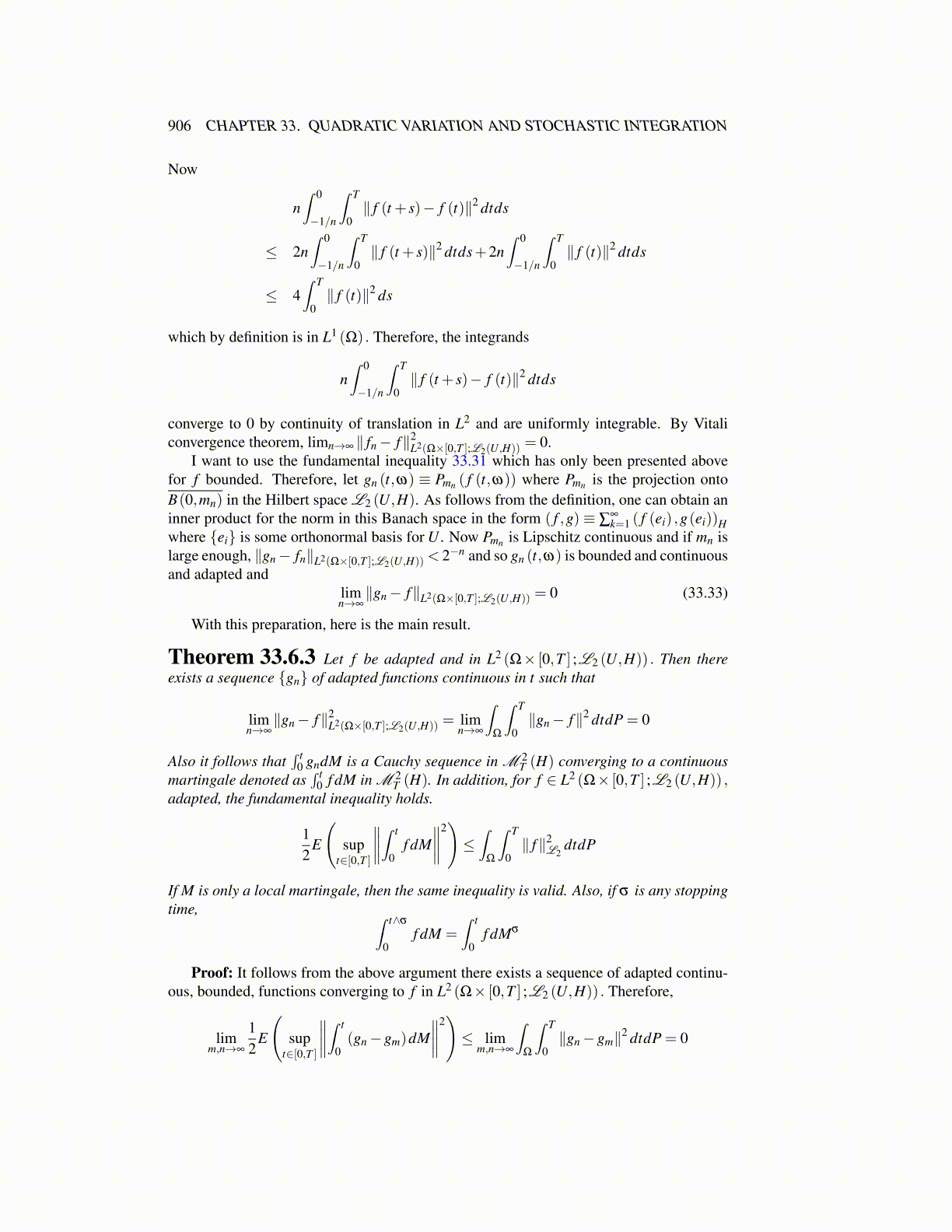
906 CHAPTER 33. QUADRATIC VARIATION AND STOCHASTIC INTEGRATION
Now
n∫ 0
−1/n
∫ T
0∥ f (t + s)− f (t)∥2 dtds
≤ 2n∫ 0
−1/n
∫ T
0∥ f (t + s)∥2 dtds+2n
∫ 0
−1/n
∫ T
0∥ f (t)∥2 dtds
≤ 4∫ T
0∥ f (t)∥2 ds
which by definition is in L1 (Ω) . Therefore, the integrands
n∫ 0
−1/n
∫ T
0∥ f (t + s)− f (t)∥2 dtds
converge to 0 by continuity of translation in L2 and are uniformly integrable. By Vitaliconvergence theorem, limn→∞ ∥ fn− f∥2
L2(Ω×[0,T ];L2(U,H)) = 0.I want to use the fundamental inequality 33.31 which has only been presented above
for f bounded. Therefore, let gn (t,ω) ≡ Pmn ( f (t,ω)) where Pmn is the projection ontoB(0,mn) in the Hilbert space L2 (U,H). As follows from the definition, one can obtain aninner product for the norm in this Banach space in the form ( f ,g) ≡ ∑
∞k=1 ( f (ei) ,g(ei))H
where {ei} is some orthonormal basis for U . Now Pmn is Lipschitz continuous and if mn islarge enough, ∥gn− fn∥L2(Ω×[0,T ];L2(U,H)) < 2−n and so gn (t,ω) is bounded and continuousand adapted and
limn→∞∥gn− f∥L2(Ω×[0,T ];L2(U,H)) = 0 (33.33)
With this preparation, here is the main result.
Theorem 33.6.3 Let f be adapted and in L2 (Ω× [0,T ] ;L2 (U,H)) . Then thereexists a sequence {gn} of adapted functions continuous in t such that
limn→∞∥gn− f∥2
L2(Ω×[0,T ];L2(U,H)) = limn→∞
∫Ω
∫ T
0∥gn− f∥2 dtdP = 0
Also it follows that∫ t
0 gndM is a Cauchy sequence in M 2T (H) converging to a continuous
martingale denoted as∫ t
0 f dM in M 2T (H). In addition, for f ∈ L2 (Ω× [0,T ] ;L2 (U,H)) ,
adapted, the fundamental inequality holds.
12
E
(sup
t∈[0,T ]
∥∥∥∥∫ t
0f dM
∥∥∥∥2)≤∫
Ω
∫ T
0∥ f∥2
L2dtdP
If M is only a local martingale, then the same inequality is valid. Also, if σ is any stoppingtime, ∫ t∧σ
0f dM =
∫ t
0f dMσ
Proof: It follows from the above argument there exists a sequence of adapted continu-ous, bounded, functions converging to f in L2 (Ω× [0,T ] ;L2 (U,H)) . Therefore,
limm,n→∞
12
E
(sup
t∈[0,T ]
∥∥∥∥∫ t
0(gn−gm)dM
∥∥∥∥2)≤ lim
m,n→∞
∫Ω
∫ T
0∥gn−gm∥2 dtdP = 0